Ring by Pietroassa

The Pietroasa ring is a gold neck ring from the early 5th century with a Gothic runic inscription . It was found in 1837 on the eastern slope of Mount Istritza near the town of Pietroassa (now Pietroasele ) in Romania . The ring was part of a hoard comprising 22 objects , which the Ostrogoths possibly tried to hide from the Huns .
Site and history
The place Pietroasele is located in the Romanian district of Buzau 100 km northeast of the capital Bucharest . Up until the first half of the 4th century there was a Roman fortress in this area, which was then burned down twice. From the second half of the 4th century, two Gothic settlements can be found in the vicinity instead . At that time the Goths were not yet threatened by the Huns. But these crossed the Don in 375 and subjugated the Ostrogoths. The Pietroassa gold treasure was buried during the rule of the Huns over the Ostrogoths, even before they liberated themselves in the Battle of the Nedao in 454 .
The gold find
The Pietroassa gold treasure consisted of 22 golden objects (bowls, jugs and fibulas ), mainly from Roman workshops, which were splendidly ornamented and set with precious stones. The finders kept it hidden in 1837 and damaged many objects by breaking off gold pieces, bending them or removing the gemstones. According to police investigations, 12 objects could still be seized. They ended up in the Bucharest Museum, from which they were stolen again in 1875. The thief damaged other objects and divided the Pietroassa ring into several parts, of which the two inscribed parts could be recovered along with most of the other objects. The rune through which the cut went has been the subject of discussion since then. The treasure was stolen again during the First World War (1916) and it was not until 1956 that it returned from Moscow to Bucharest, where it is now exhibited in the National Museum of the History of Romania .
Inscription and interpretation
The inscription on the neck ring is in the older Futhark and clockwise:
- gutani o wi hailag
The separation of the words corresponds to the arrangement of the runes on the neck ring. Four words can be read from the 15 letters:
- Gutani o (þal) wi (h) hailag
The o- rune does not stand individually for its sound value, but its run name * oþala . This means "inherited property". The added h in wi (h) ("consecrated") is explained by the fact that double consonants are not written in runic script, mostly to save space. In normalized Wulfila - Gothic the inscription would read:
- Gutane oþal Weih hailag
Translation according to Nedoma :
- "inheritance of the Goths, consecrated [and] inviolable / sanctified"
The inscription is unmistakably Gothic. On the one hand the tribe name is mentioned, on the other hand the h- rune has only one crossbar. In the other continental runic inscriptions and in Anglo-Saxon Futhark , this rune has two crossbars. It is believed that the inscription was not placed immediately before the treasure was deposited. With such fresh scratches, bulges would otherwise appear on the scratched edges, which could not be detected. In addition, the ring shows signs of use, which suggest longer use. The user could have been a higher-ranking personality, prince or priest. According to Wolfgang Krause, a weakly recognizable symbol ( three vertebrae or swastika ) is carved under the runes o and w , which could underline a religious use.
History of interpretation
After the discovery of the inscription and its becoming known at the world exhibition in Paris in 1867 , interpretations appeared in many publications (including by Wilhelm Grimm and Rudolf Virchow ). However, one read the runes:
- gutan (e) iowi hailag ( Dedicated to the Goths Jupiter )
With the god Jupiter one meant to have found a reference to Thor . One could only come to such an interpretation if one ignored the separation of the words and added the i at the end of gutani to the o . Nevertheless, this interpretation was considered the most conclusive and was widely used. After the inscription had been divided into two parts, doubts arose about the sound value of the destroyed rune, as only a few branches were visible. The runes j , s, and even ng have been suggested. Finally, an agreement was reached on j when a photo of the neck ring, taken before the theft, appeared, in which the o-rune was clearly recognizable.
See also
Individual evidence
- ↑ Harhoiu: RGA vol. 23 p. 147
- ↑ a b Nedoma: RGA vol. 23 p. 157
- ↑ Krause: Runes p. 87
- ↑ Düwel: Runenkunde (4th edition) p. 32
- ↑ Düwel: Runenkunde (3rd edition) p. 32
- ^ Looijenga: p. 97
- ↑ Pieper: RGA 23 p. 154
literature
- Klaus Düwel: Runic lore. 4th edition. Metzler, Stuttgart Weimar 2008, ISBN 3-476-13072-X .
- Harhoiu, Pieper, Nedoma: Pietroassa In: Reallexikon der Germanischen Altertumskunde Vol. 23 (2nd edition) Berlin, New York 2003. pp. 147–158.
- Tineke Looijenga: Runes around the North Sea and on the Continent AD 150-700 . Pp. 96-97.
- Robert Nedoma: Script and Language in the East Germanic Runic Inscriptions , NOWELE, 58/59 (2010), pp. 1–70.
- Wolfgang Krause: Runes. de Gruyter, Berlin New York 1993 (2nd unchanged edition). P. 87

